!!! My website has
moved: please update your bookmarks to debunix.net !!!
'Spawning' Thorichthys sp. “Blue Mixteco”
by Diane Brown
When I got back into fishkeeping in 2001, I started with Endler’s
livebearers, who lived up to their nickname of “Endless
livebearers. I later acquired some killies, and found that fry of
Fundulopanchax gardneri appeared at irregular intervals in my planted
tanks without any deliberate intervention on my part. While I
enjoyed watching their courting behaviors, I decided I wanted to watch
some real fish parenting—I wanted to try some cichlids. I started
with a group of 8 Etroplus maculatus, the orange chromide, but despite
my attempts to give them a well-planted brackish tank with plenty of
cover and potential spawning sites, these gentle golden fish did
nothing except go belly up after a year and a half, after what I
suspect was an end-of-tank CO2 dump that barely distressed any of my
other fish in tanks on the same CO2 system.
I wanted to try again, with small, mild-mannered strictly freshwater
fish this time, and obtained a group of Laetecara dorsigerus fry.
While they were still in a quarantine tank in the fall of 2003, Rusty
Wessel came to a MASI meeting to talk about collecting Central American
cichlids. I was attracted by the Thorichthys sp. “Blue mixteco”,
and after verifying that they did not grow larger than four inches,
were relatively mild-mannered, and could be kept with plants, I bid on
a bag of six fry….thinking all the while that I was nuts to get more
cichlids when I had just gotten the dorsigers. But while the
dorsigers have thrived, indeed, gotten quite large and plump, they have
never attempted to spawn. The Thorichthys, on the other hand,
have proven quite eager to spawn.
When I brought them home, the Thorichthys fry were about an inch long
and very lively. They made themselves right at home in a 29G
heavily planted tank and grew quickly. (Tank parameters: (T 78
degrees and up to mid-80s in the summer, pH neutral, CO2 injected, soft
St. Louis tap water dechlorinated with thiosulfate alone.) Within
3 months of generous feeding with a variety of dried, frozen, and live
food twice daily, one was about three times the size of the rest of
them, and Big Fish remained the largest, most dominant fish in the tank
thereafter.
One evening that next summer, when Big Fish was four inches long and
the rest were about 3 inches long, I spotted Big Fish and one other
paired up and guarding a patch of dozens to a couple of hundred
translucent 1-2 mm eggs. The eggs were attached to the sheet of cork
bulletin board material covering the back wall of the tank. (put there
as a support for plants, to increase the plantable surface area of the
tank, and happily appropriated as a spawning substrate by the
thorichthys). The eggs gradually disappeared over the next 48hrs
and no wigglers or fry were seen, despite faithful guarding of the
spawning site by both parents, and frequent chases of the other fish in
the tank (the other thorichthys, six zebra loaches, and a pair of
fundulopanchax gardneri). I suspected the snails and loaches were
getting at them at night. The loaches were evicted, but the
snails remained. No further paired behavior was seen, and Big
Fish seemed to chase the others around equally.
A month of two later, more eggs appeared, this time guarded only by Big
Fish.
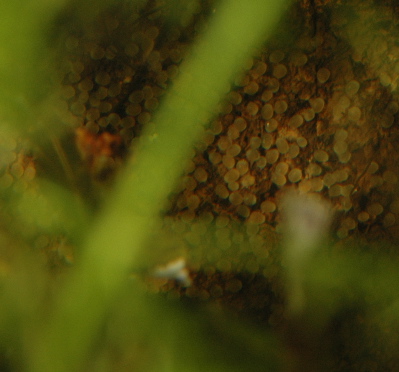
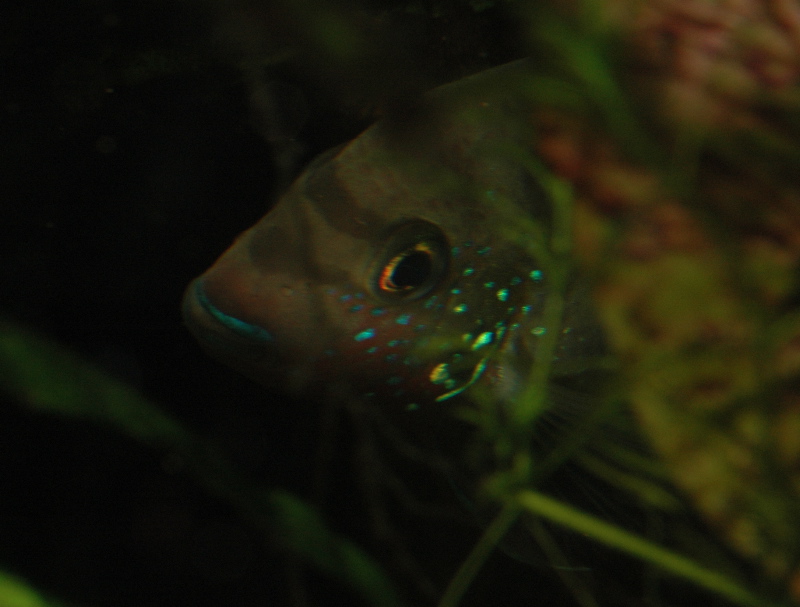
I left the lights on 24/7 and the egg patch remained intact, but over
the next three days they turned white and disappeared.

After another pair of infertile spawns, I was suspected I might have
only females. The females of this species all have black spots in
their dorsal fins, and I saw those in all the thorichthys in the
tank. I was depressed enough to calculate the odds of 6/6 fry
being female: assuming a 50:50 sex distribution, you have 50:50
shot of a pair with two fry, 75:25 with three, 87.5:12.5 for four,
93.75:6.25 for five, and 96.875:3.125 for six. And I heard rumors
that other people raising these fish were seeing male-skewed sex
ratios, making the odds further stacked against getting a batch of six
females.
However, when trimming and cleaning the tank for the MASI fish room
tour in September, I saw that the smallest fish in the tank didn’t seem
to have the dorsal spots. His fins were shredded, he had one
damaged eye, and I could hardly blame him for staying so well hidden
I’d not realized he was there. Any time he came out he was chased
mercilessly by whichever female was nearest. I removed him
to an empty 29G tank where his only companions were a pair of Endlers,
and he grew and his fins filled out rapidly. After a few months,
he was as big as Big Fish, and I was ready to reintroduce him to the
girls.
I first put a divider in his tank and put Big Fish on the other
side.
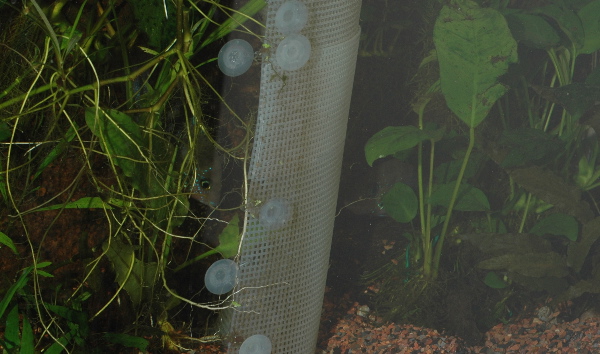
There was little flaring of gills or rushing at the divider, so I
planned to remove it the next evening when I did my water changes—so I
could watch closely and return it in case of trouble. But they
didn’t
wait for me; the next day there were a batch of eggs laid on the cork
wall right next to the divider, 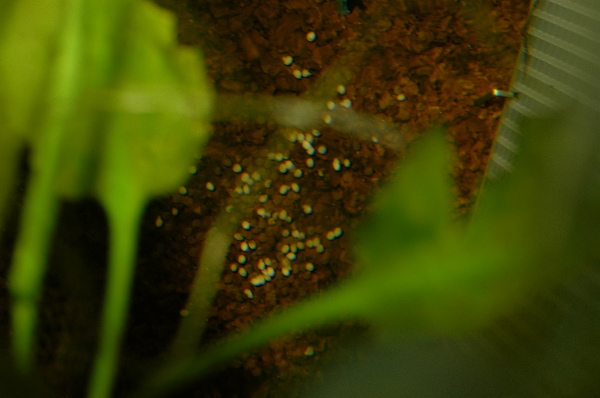
Big Fish was guarding, and the male, in dark striped breeding garb, was
digging troughs all over his side of the tank.
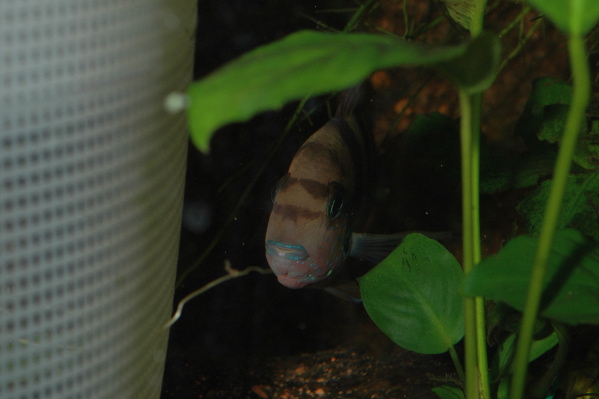
These eggs were again infertile, however, and were gone by the fourth
day.

I waited a couple of days, removed the barrier, and watched
carefully. Within an hour they’d figured out the barrier was
gone, and the male was chasing Big Fish aggressively around the
tank.
I did not want to return the big female to her original tank, leaving
the male alone again—he’d shown he was ready to spawn with somebody--so
I put him back in the other tank instead, with the four smaller
females. I hoped that forcing him to be the newcomer to an
established tank, and having four others in that tank, would dilute his
aggression towards any one fish.
By the next morning, he had already paired off with the smallest female
in the tank.
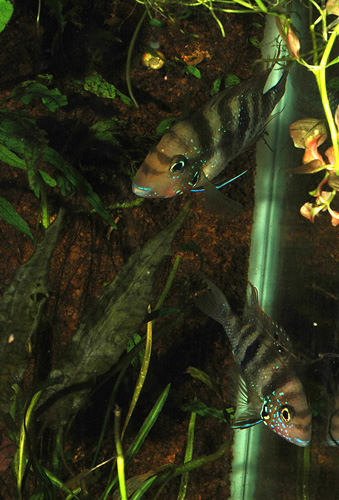
Emboldened by having the male at her back she proceeded to establish
herself as the boss. The pair injured one of the others badly
enough that I removed her to a hospital tank for a few days, and over
the next two days I moved the remaining females out to share the second
tank with the big female (they since found a new home, where Big Fish
has continued to lay infertile spawns).
The pair were displaying to each other, swimming parallel with gills
flaring, bright red throats flashing, black vertical stripes darkened,
and their blue spots and fin stripes were sparklingly brilliant.
They'd also do the same thing when head to tail, but never head to head
in an aggressive way, and never chasing one after the
other. And after there were no other fish left to chase
(they essentially ignore the pair of fundulopanchax gardneri who share
the tank, who are smart enough to stay away from the bigger cichlids
without prompting), the pair spent most of their time together. About
four days after they paired up, I came home to find Little Fish
guarding eggs.
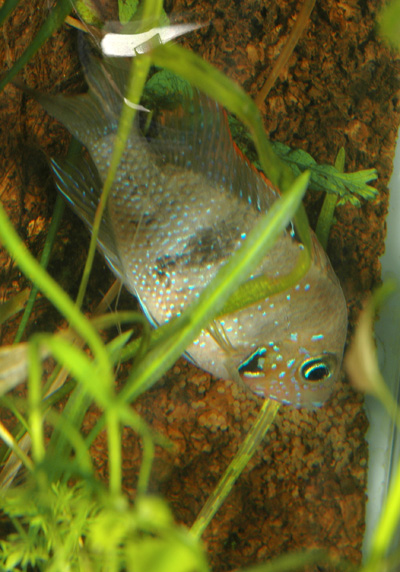
The day after spawning the eggs looked a little different--they were
developing. After so many batches of infertile, unchanging eggs
(well, at least until they turned white and fungused!) even this little
difference was exciting. The next morning I was looking closely
at the tank while feeding and saw a tiny fish swimming, but then I
looked again at the unhatched eggs, and realized I was looking at a
little gardneri that had managed to hatch and grow up while the tank
was nearly empty and the larger fish were otherwise preoccupied.
On the evening of the third day I found wigglers, which had been moved
a few inches over into a clump of java fern rootlets. They still looked
more like eggs than fish, with bodies like ghostly tails on the eggs.
The female seemed to spend a lot of time going from the gravel to the
rootlets, perhaps picking up fallen fry and moving them back up to the
roots. The male took turns guarding while the female fed, and
rearranged the aquascaping when she was on duty—digging pits, uprooting
plants, and resisting my occasional attempts to replant and restore
order.
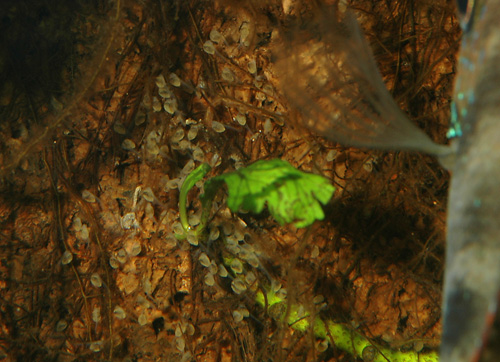

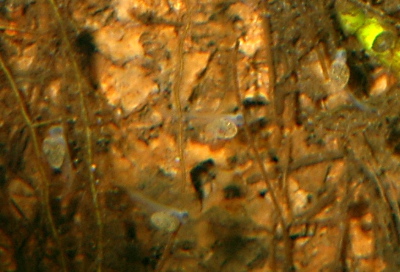
By day four after hatching they were genuine wigglers--wriggling like
crazy on their strands of roots. And the male began to take a
more active role--no longer hiding out in the shadows of the java fern
or digging puts, but spending more time with the female and the
wigglers. And he came up to the glass—gills flaring and bright
red throat puffed out--to challenge me when I first walked into the
room. That evening there were fewer wigglers visible, and the
next day there were none.
The female continued to guard the site for another day before giving
up. She and the male continued to display to each other, however,
and 10 days after the first spawn there was a new batch of eggs at the
original site, and the female was back on guard.

The male would greedily eat when I fed the gardneri at the other end of
the tank. The female, however, was so determined not to eat that
a
wiggly piece of fresh redworm dropped carefully right in front her of
was not eaten, but instead picked up and spit out a distance away,
presumably to keep a potential threat from her eggs. That's
dedication!
The wigglers hatched again on the third day after laying. By the
third day after hatching they looked about equal parts fish and yolk
sac. The female was now back to eating; she and the male took
turn foraging on the other side of the tank where I am dropped
bloodworms and grindals. The parents' cooperation seemed much
smoother this time around, and this time the group of wigglers wasn’t
visibly shrinking each day. I placed a sponge over the filter
intake and kept it there until the fry were about 1 cm long.
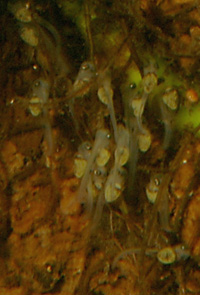
I was taking pictures of the brood daily, and just after one photo
session, when I went back to admire the wigglers again, they were
GONE. Every last one was missing. The female was still
brooding in the same place, the male was hiding behind the java fern,
the gardneri were nowwhere to be seen. I looked closely at the
gravel pit in front of the female, no wigglers. Then I saw a
collection of mulm just at the base of the tank wall, right below the
spot where they'd been hung in the roots, and realized the mulm was
moving and had eyes--it was the wigglers. The female had moved
them off the cork wall. And they remained there for the next two
days.
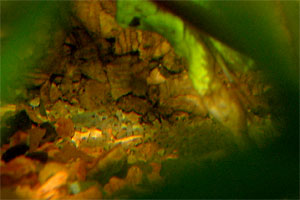
Naturally they waited until I left town for the weekend before becoming
free-swimming. My caretaker fed the adults but the fry were left
to graze on infusoria until I returned. The parents
traveled the perimeter of the cloud of fry to grab the stray fry, often
with a mouthful of gravel and debris, carry it back to the main group,
and spit out the fry where they belong. They were kept quite busy
doing this, and seemed to have thoroughly intimidated the gardneri that
shared the tank--I didn’t see them stray below the top inch of the tank
on the far side from where the fry were headquartered. The
fry, now about 5mm long, eagerly accepted freeze-dried cyclop-eeze or
tetra fry bites powder each morning and brine shrimp nauplii and
microworms each evening.

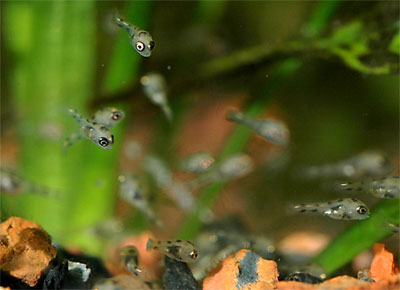
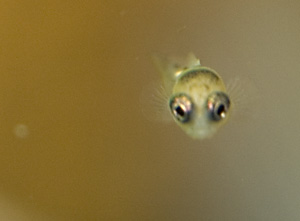
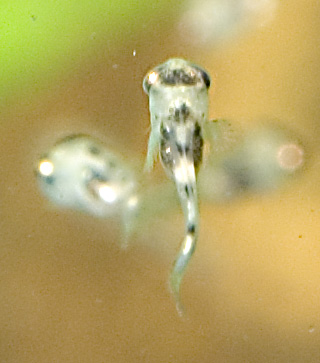
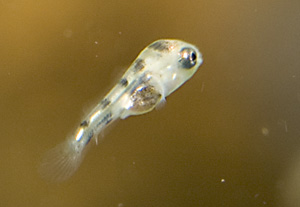
I was treated to this sort of threat display (here the male with his
throat extended) several times a day if I ventured too close--and
anywhere within 6-8 feet was too close, by their reckoning:

A month after spawning, the 1 cm fry were taking small grindal worms,
crushed flake food, and Hikari micro pellets in addition to the
cyclop-eeze and brine nauplii.
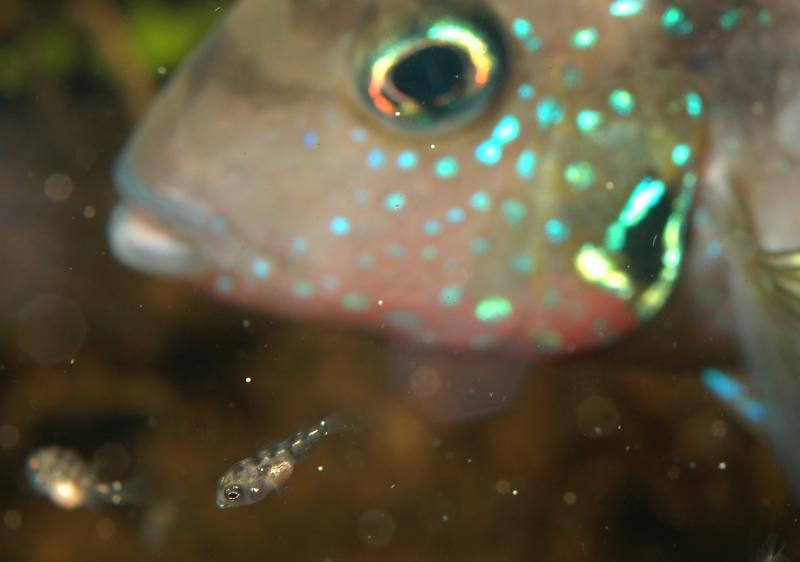
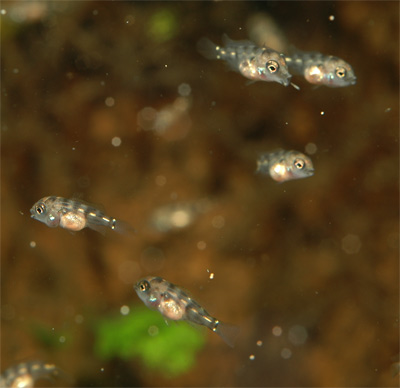
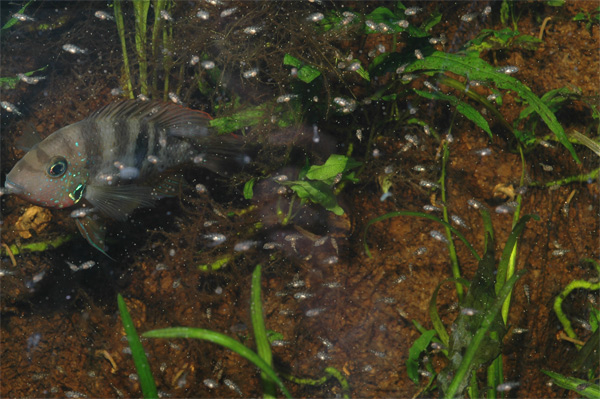
About six weeks after spawning, the adults gradually stopped overtly
guarding the fry, and spent more time in hiding. I don’t know
whether
they were spawning again (but not in the usual place) or just trying to
find some peace and quiet, but they were still displaying to each other
when they did come out. And after a week or ten days of that, the
male
began to chase the female aggressively—no more parallel displays—and I
removed her from the tank to prevent injury. He seemed to ignore
the
fry, but I suspected that the problem may have been overcrowding, as
the 200+ fry, now 1 1/2-2 1/2 cm long, quite filled the tank.
They were
still a little small, yet, to sex out clearly, as only a few of the
largest were starting to show a shadow of a possible female dorsal
marking.
When they had just turned 60 days old (the minimum for BAP), it was
fish rodeo time. I rounded up the young 'uns for the MASI
auction, and by draining the tank completely--carefully herding the fry
towards the last puddle as I drained it to below the level of the
gravel--I thought I'd gotten them all. I bagged up about 200 fry
altogether. Then I refilled the tank, put the male back in, and
was astonished to see 5 fry appear out of nowhere. Were they
hiding in the gravel? Hiding in the plant roots on the tank
wall? The tank was mostly empty for at least half an hour before
it was refilled, so their survival was quite a feat. Those fry
survived and prospered, but unfortunately their parents relationship
came to a bad end.
A few days later I put the female back into the tank, thinking the
adults would be be ready to pair off again. At first they ignored
each other, then the male chased her a little, but nothing that seemed
particularly aggressive. The following evening when I came home
from work, however, I found her in distress, barely swimming, and
though I got her isolated in a hospital tank, she did not
survive.
I gave away the male and remaining females to a friend with more space,
and concentrated instead on raising the next generation. It was
quite an adventure, being able to experience typical cichlid spawning
behavior without needing a large tank. And unlike the chromides and
dorsigers, who seemed to prefer hiding to spawning, these fish were so
eager to spawn they’d do it repeatedly without a partner. While
it wa not easy pairing them up, and the pairings were sometimes
violent, I was able to watch them spawn and raise the fry in plain
sight, in my living room, allowing me and any guests to track every
step of the process. What more could a beginning cichlidiot ask
for?
Return
to My Fishroom
Back to
Fish Page
Return to Diane's Home Page



















